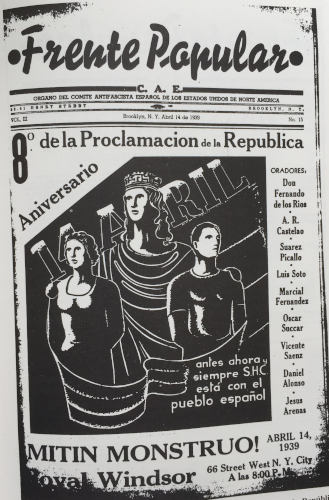Sociedades Hispanas Confederadas
Group of anti-fascist societies created in Brooklyn in 1936.

Group of antifascist societies created in Brooklyn in 1936 by Spaniards and Latin Americans. It was originally called Comité Antifascista Español, and had an important Galician representation, not only because of Galician societies such as the Frente Popular Antifascista Gallego (which was part of the group and therefore provided a significant number of members), but also because of individual contributions by some of its members, for example Xosé Castro and Domingo Alonso, who both held the position of secretary general. Xosé Pantín also played an important role in the creation of the Comité Antifascista Español. Other Galicians who were particularly active were Manuel Alonso (Pontevedra) and Francisco Mares (O Carballiño).
From 1937, the SSHHCC published the newspaper Frente Popular, which later became España Libre and existed until 1976. Xosé Castro was one of its editors. Throughout its almost forty years of existence, España Libre included cultural and opinion articles about Galicia and Galicians in the US. Galician societies and businesses run by Galicians also appeared regularly in the advertisements section. Galician exiles such as José Rubia Barcia signed some of the sharper articles against the dictatorship and its international acceptance, with strong criticism of US support.
Despite appearing as a united group during the war, due to ideological discrepancies between communists, anarchists and nationalists from Galicia, Catalonia and the Basque Country, some societies (such as the FPAG) abandoned the group after Franco’s victory (Sources: Emilio González López, Castelao, propagandista da República en Norteamérica (2000); “Los españoles de los Estados Unidos y la guerra civil (1936-1939)” (1994) by Marta Rey García; “Las Sociedades Hispanas Confederadas en archivos del FBI (emigración y exilio español de 1936 a 1975 en EEUU)” (2006), by María Ángeles Ordaz Romay).